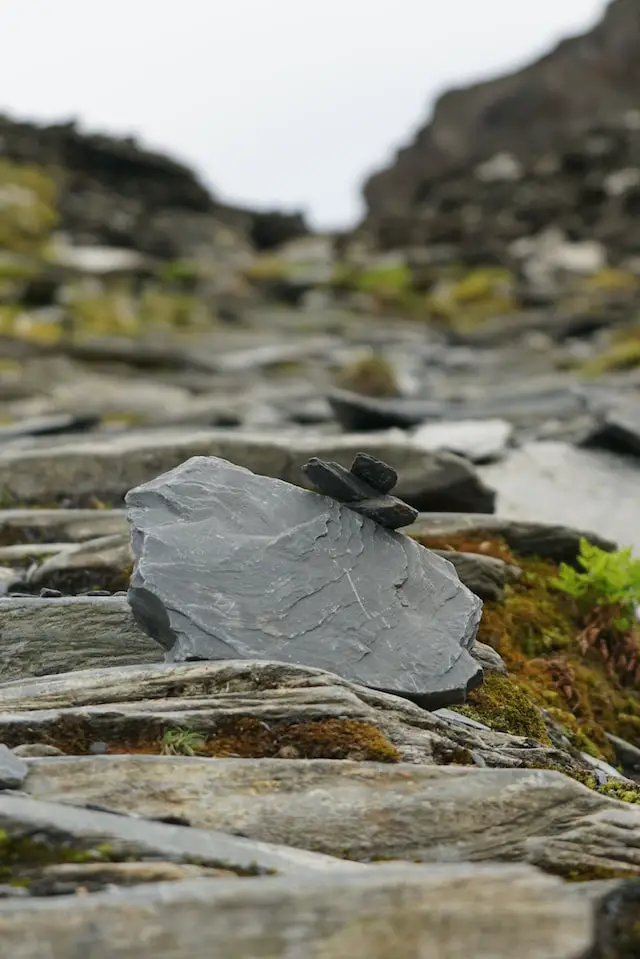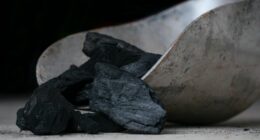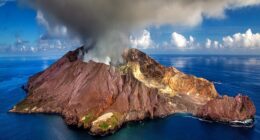Intrusive rocks are formed when magma cools and solidifies below the earth’s surface, while extrusive rocks are formed when magma cools and solidifies above the earth’s surface
Intrusive rocks
(Photo By James St. John on Flickr)
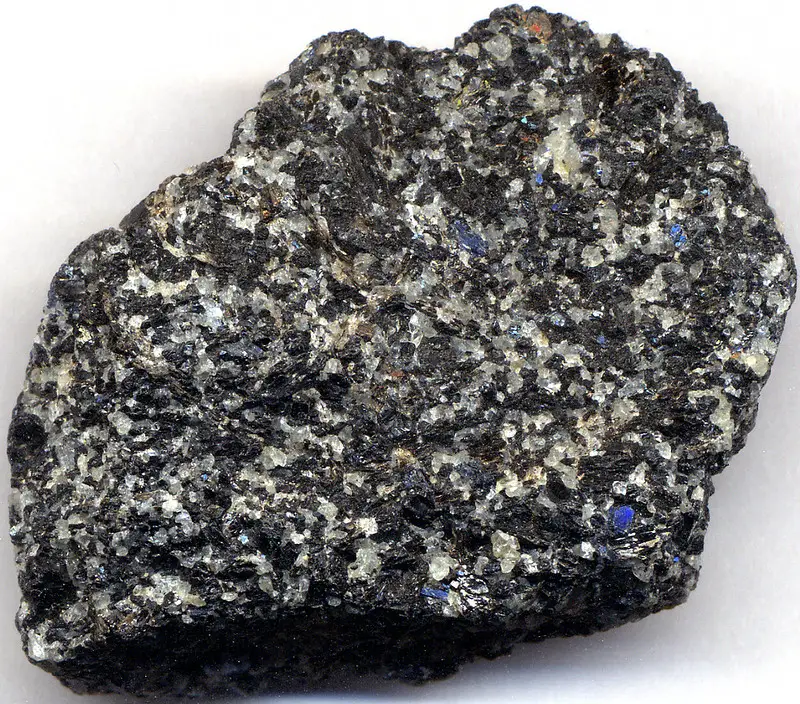
Intrusive rocks are a type of igneous rock that form from the cooling and solidification of magma beneath the Earth’s surface. They are called “intrusive” because they intrude or penetrate into existing rock formations, rather than erupting onto the Earth’s surface like extrusive rocks.
Intrusive rocks are typically coarse-grained, meaning that the individual mineral grains that make up the rock are large enough to be seen with the naked eye. This is because the slow cooling of magma beneath the Earth’s surface allows for the formation of large mineral crystals. Common examples of intrusive rocks include granite, diorite, and gabbro.
One of the main characteristics of intrusive rocks is their intrusive nature. As they cool and solidify underground, they can push their way into existing rock formations, causing a variety of geological features such as dikes, sills, and batholiths. These features can be important for mineral exploration, as they often contain valuable mineral deposits.
Intrusive rocks can also provide important information about the geologic history of an area. By studying the composition, texture, and distribution of intrusive rocks, geologists can learn about the processes that shaped the Earth’s crust over millions of years. This can help them to better understand the formation of mountains, the movement of tectonic plates, and the evolution of the Earth’s surface over time.
Intrusive rocks are an important type of igneous rock that play a crucial role in the study of geology and the Earth’s history.
Extrusive rocks
(Photo By James St. John on Flickr)
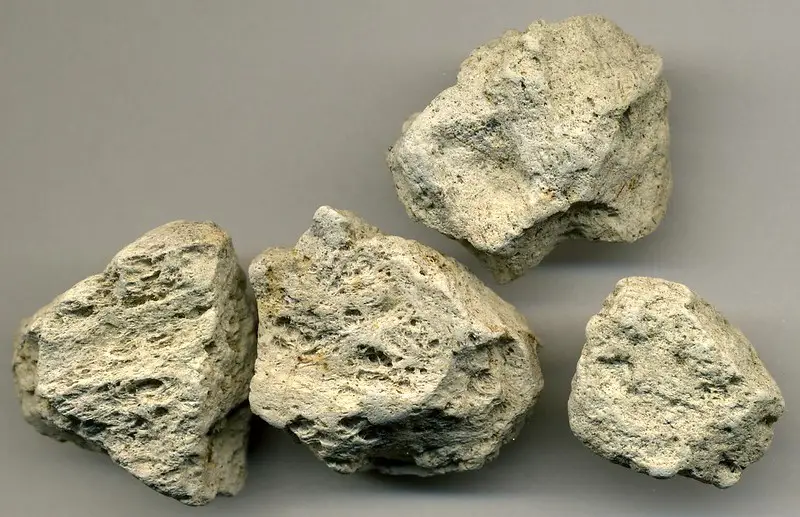
Extrusive rocks are a type of igneous rock that form from the solidification of lava on the Earth’s surface. They are called “extrusive” because they extrude or erupt onto the Earth’s surface from volcanic vents, rather than solidifying beneath the Earth’s surface like intrusive rocks.
Extrusive rocks are typically fine-grained, meaning that the individual mineral grains that make up the rock are too small to be seen with the naked eye. This is because the rapid cooling of lava on the Earth’s surface does not allow for the formation of large mineral crystals. Common examples of extrusive rocks include basalt, andesite, and rhyolite.
One of the main characteristics of extrusive rocks is their volcanic origin. They are formed through the eruption of magma onto the Earth’s surface, which can result in a variety of geological features such as volcanic cones, lava flows, and volcanic ash deposits. These features can have important implications for the study of volcanoes, as they can provide information about the history and behavior of past eruptions.
Extrusive rocks can also be important for a variety of practical applications. For example, basalt is commonly used in construction for its strength and durability, while pumice (a type of extrusive rock formed from volcanic ash) is used as an abrasive in industries such as cleaning and polishing.
Overall, extrusive rocks are an important type of igneous rock that play a crucial role in the study of geology and the Earth’s history, as well as in a variety of practical applications.
Intrusive rocks Vs. Extrusive rocks – Key differences
Intrusive rocks and extrusive rocks are two types of igneous rocks that differ in their mode of formation and characteristics. Here are some key differences between the two:
Formation: Intrusive rocks form from the cooling and solidification of magma beneath the Earth’s surface, while extrusive rocks form from the solidification of lava on the Earth’s surface.
Texture: Intrusive rocks are typically coarse-grained, meaning that the individual mineral grains that make up the rock are large enough to be seen with the naked eye. Extrusive rocks, on the other hand, are typically fine-grained, with the individual mineral grains too small to be seen with the naked eye.
Cooling rate: Because intrusive rocks form beneath the Earth’s surface, they cool slowly, which allows for the formation of large mineral crystals. Extrusive rocks, on the other hand, cool quickly on the Earth’s surface, which does not allow for the formation of large mineral crystals.
Location: Intrusive rocks are found beneath the Earth’s surface, while extrusive rocks are found on the Earth’s surface, typically in areas of volcanic activity.
Geological features: Intrusive rocks can intrude or penetrate existing rock formations, causing geological features such as dikes, sills, and batholiths. Extrusive rocks, on the other hand, can result in geological features such as volcanic cones, lava flows, and volcanic ash deposits.
Applications: Intrusive rocks are often used for building materials and decorative purposes due to their durability and attractive appearance. Extrusive rocks, on the other hand, have a wide range of applications, including construction materials, abrasives, and as a source of minerals.
The differences between intrusive rocks and extrusive rocks relate to their mode of formation, texture, cooling rate, location, geological features, and applications.
What are examples for Intrusive rocks?
Some examples of intrusive rocks include:
- Granite: a coarse-grained igneous rock composed of primarily quartz, feldspar, and mica.
- Diorite: a medium to coarse-grained igneous rock composed of plagioclase feldspar and hornblende.
- Gabbro: a coarse-grained igneous rock composed of mainly plagioclase feldspar and pyroxene.
- Peridotite: a dense, ultramafic rock composed of mainly olivine and pyroxene.
- Syenite: a coarse-grained igneous rock composed of primarily alkali feldspar and lesser amounts of hornblende and mica.
- Pegmatite: a very coarse-grained igneous rock composed of large crystals of feldspar, mica, and quartz.
These rocks are typically found beneath the Earth’s surface and are formed through slow cooling and solidification of magma.
What are examples for Extrusive rocks?
Some examples of extrusive rocks include:
- Basalt: a fine-grained igneous rock composed of primarily plagioclase feldspar and pyroxene.
- Andesite: a fine-grained igneous rock composed of plagioclase feldspar and hornblende.
- Rhyolite: a fine-grained igneous rock composed of primarily quartz, feldspar, and mica.
- Obsidian: a glassy, dark-colored igneous rock formed from rapidly cooling lava.
- Pumice: a light-colored, porous igneous rock formed from frothy lava.
- Tuff: a volcanic rock composed of compacted volcanic ash and fragments of other volcanic rocks.
These rocks are typically formed on or near the Earth’s surface through the rapid cooling and solidification of lava. They have a fine-grained texture due to the quick cooling process.
Featured Image By – Martin Turgoose on Unsplash
